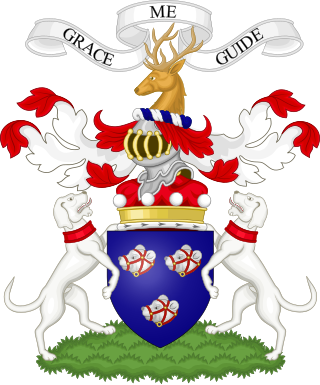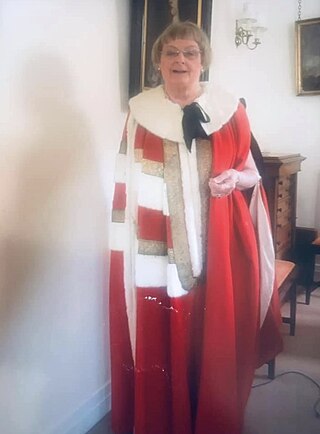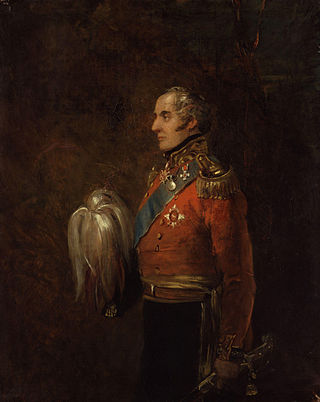
Alexander Arthur Alfonso David Maule Ramsay of Mar, DL was the only child of Princess Patricia of Connaught, who renounced her royal title and style when she married then-Captain the Hon. Alexander Ramsay in February 1919. His mother was the youngest child of Prince Arthur, Duke of Connaught, the third son of Queen Victoria and Prince Albert. His father was the third son of John Ramsay, 13th Earl of Dalhousie. Through the marriage of his maternal aunt, Princess Margaret of Connaught, to the Swedish prince who later became King Gustav VI Adolf of Sweden, his first cousins included Prince Gustaf Adolf, Duke of Västerbotten, whose son later became King Carl XVI Gustaf of Sweden; and Princess Ingrid of Sweden, who later became Queen of Denmark after marrying the Danish prince who later became King Frederik IX of Denmark.

Earl of Rothes is a title in the Peerage of Scotland. It was created in 1458 for George Leslie, 1st Lord Leslie. He had already been created Lord Leslie in 1445, also in the Peerage of Scotland. His grandson, the third Earl, having only succeeded his elder brother in March 1513, was killed at the Battle of Flodden on 9 September of the same year. His son, the fourth Earl, served as an Extraordinary Lord of Session. Lord Rothes was also tried for the murder of Cardinal Beaton but was acquitted.

Lord Forbes is the senior Lordship of Parliament in the Peerage of Scotland.

Lord Gray is a title in the Peerage of Scotland. The Barony of Gray was created circa July 1445 for the Scottish diplomat and politician Sir Andrew Gray. The first Lord Gray was a hostage in England for the good conduct of James I of Scotland from 1424 to 1427, and was one of the knights who accompanied Lady Margaret Stewart to France for her marriage to Louis XI of France in 1436.

Lord Elphinstone is a title in the Peerage of Scotland created by King James IV in 1510.

Lord Balfour of Burleigh, in the County of Kinross, is a title in the Peerage of Scotland. It was created in 1607 for Sir Michael Balfour.

Lord Sempill is a title in the Peerage of Scotland. It was created in circa 1489 for Sir John Sempill, founder of the collegiate Church of Lochwinnoch. Sempill was killed at the Battle of Flodden in 1513. His grandson, the third Lord, was known as "The Great Lord Sempill". His grandson, the fourth Lord, was Ambassador from King James VI of Scotland to Spain in 1596. The male line failed on the death of his great-grandson, the eighth Lord, in 1684. He was succeeded by his sister Anne, wife of Robert Abercromby, who in 1685 was created Lord Glassford for life. In 1688 she obtained a new charter settling the lordship of Sempill in default of male issue, upon her daughters without division by her then and any future husband. Her younger son, the twelfth Lord, commanded the left wing of the government army at the Battle of Culloden in 1746.

Lord Napier, of Merchistoun, is a title in the Peerage of Scotland. It was created in 1627 for Sir Archibald Napier, 1st Baronet. Earlier that year, he already held the Napier Baronetcy, of Merchistoun in the County of Midlothian, created in the Baronetage of Nova Scotia. The titles remained united until 1683, when the Baronetcy became dormant. It was revived in the early 19th century and is now held by another branch of the Napier family. Between 1683 and 1686, the Lords of Napier also held the Nicolson Baronetcy, of Carnock in the County of Stirling, and since 1725 the Scott Baronetcy, of Thirlestane in the County of Selkirk, both baronetcies created in the Baronetage of Nova Scotia. The latter is still held today. Additionally, the tenth Lord was created Baron Ettrick, of Ettrick in the County of Selkirk in the Peerage of the United Kingdom on 16 July 1872.

Flora Marjorie Fraser, 21st Lady Saltoun, was a Scottish noblewoman and Crossbench peer. Until her retirement on 12 December 2014, she was the only holder of a lordship of Parliament with a seat in the House of Lords as an elected hereditary peer.

Kinnaird Head is a headland projecting into the North Sea, within the town of Fraserburgh, Aberdeenshire, on the east coast of Scotland. The 16th-century Kinnaird Castle was converted in 1787 for use as the Kinnaird Head Lighthouse, the first lighthouse in Scotland to be lit by the Commissioners of Northern Lights. Kinnaird Castle and the nearby Wine Tower were described by W. Douglas Simpson as two of the nine castles of the Knuckle, referring to the rocky headland of north-east Aberdeenshire. The lighthouse is a category A listed building. and the Wine Tower. is a scheduled monument. The buildings around the base of the lighthouse are the work of Robert Stevenson.
Katharine Ingrid Mary Isabel Fraser, 22nd Lady Saltoun,, is a British peer. She is the daughter of Alexander Ramsay of Mar and Flora Fraser, 21st Lady Saltoun. As the granddaughter of Princess Patricia of Connaught, she is a second cousin of King Carl XVI Gustaf of Sweden and Queen Margrethe II of Denmark, and a distant relative of the British royal family.
Alexander Arthur Fraser, 20th Lord Saltoun,, styled Master of Saltoun until 1933, was a Scottish peer who was one of the longest-serving representative peers, serving in the House of Lords from 1935 to 1963.
Alexander William Frederick Fraser, 19th Lord Saltoun was a Scottish representative peer, military officer, and freemason.

Clan Fraser is a Scottish clan of the Scottish Lowlands. It is not to be confused with the Clan Fraser of Lovat who are a separate Scottish clan of the Scottish Highlands. Both clans have their own separate chief, both of whom are officially recognized by the Standing Council of Scottish Chiefs.
The Frasers of Philorth are a Scottish lowlands family, originally from the Anjou region of France. Castle Fraser, their family seat, is in Sauchen, Aberdeenshire, Scotland. Since the time of Alexander Fraser, 11th Lord Saltoun, the heads of the Philorth family are the Lords Saltoun. The current head of the Frasers of Philorth is Katharine Fraser, 22nd Lady Saltoun, who is Chief of the Name and Arms of Clan Fraser. The family's arms are "azure, three cinquefoils argent"—three silver strawberry flowers on a field of blue. The heraldic cinquefoil is a stylized five-point leaf; the cinquefoils which appear on the Fraser of Philorth coat-of-arms are specifically strawberry flowers. Only the Lady or Lord Saltoun is permitted to display these arms plain and undifferenced.
The following is a list of the chiefs of the Clan Fraser of Lovat. The Chiefs of Clan Fraser often use the Gaelic patronym MacShimidh.
Alexander Fraser, 11th Lord Saltoun, was a Scottish peer and the 10th Laird of Philorth.

Lieutenant-General Alexander George Fraser, 17th Lord SaltounKStG KMT, was a Scottish representative peer and a British Army general who fought in the Napoleonic Wars and the First Opium War.
William Fraser, 12th Lord Saltoun, was a Scottish peer and the 11th Laird of Philorth.

Alexander Fraser of Philorth was a Scottish landowner and founder of Fraserburgh.











